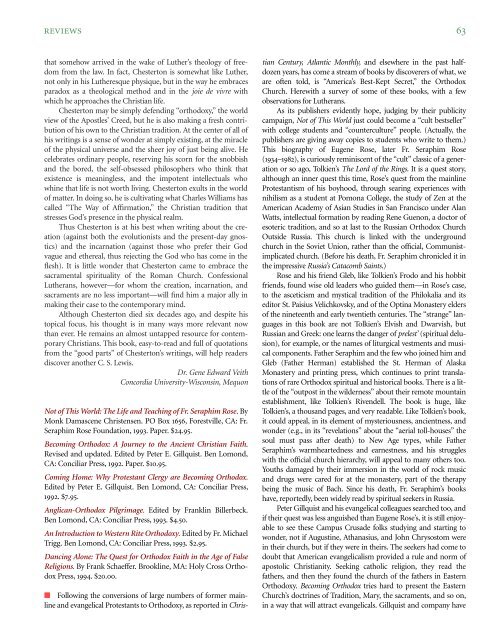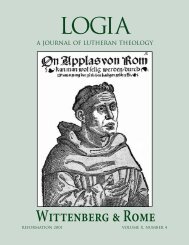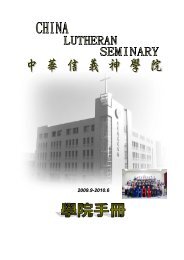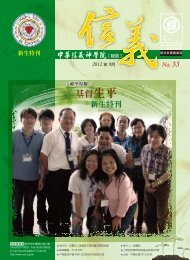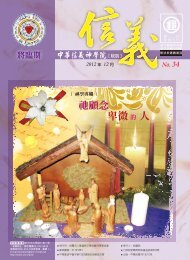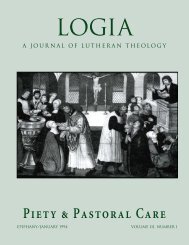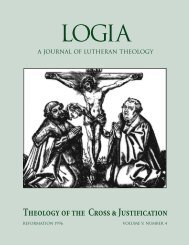04-2 Hermeneutics.pdf
04-2 Hermeneutics.pdf
04-2 Hermeneutics.pdf
- No tags were found...
You also want an ePaper? Increase the reach of your titles
YUMPU automatically turns print PDFs into web optimized ePapers that Google loves.
REVIEWS 63that somehow arrived in the wake of Luther’s theology of freedomfrom the law. In fact, Chesterton is somewhat like Luther,not only in his Lutheresque physique, but in the way he embracesparadox as a theological method and in the joie de vivre withwhich he approaches the Christian life.Chesterton may be simply defending “orthodoxy,” the worldview of the Apostles’ Creed, but he is also making a fresh contributionof his own to the Christian tradition. At the center of all ofhis writings is a sense of wonder at simply existing, at the miracleof the physical universe and the sheer joy of just being alive. Hecelebrates ordinary people, reserving his scorn for the snobbishand the bored, the self-obsessed philosophers who think thatexistence is meaningless, and the impotent intellectuals whowhine that life is not worth living. Chesterton exults in the worldof matter. In doing so, he is cultivating what Charles Williams hascalled “The Way of Affirmation,” the Christian tradition thatstresses God’s presence in the physical realm.Thus Chesterton is at his best when writing about the creation(against both the evolutionists and the present-day gnostics)and the incarnation (against those who prefer their Godvague and ethereal, thus rejecting the God who has come in theflesh). It is little wonder that Chesterton came to embrace thesacramental spirituality of the Roman Church. ConfessionalLutherans, however—for whom the creation, incarnation, andsacraments are no less important—will find him a major ally inmaking their case to the contemporary mind.Although Chesterton died six decades ago, and despite histopical focus, his thought is in many ways more relevant nowthan ever. He remains an almost untapped resource for contemporaryChristians. This book, easy-to-read and full of quotationsfrom the “good parts” of Chesterton’s writings, will help readersdiscover another C. S. Lewis.Dr. Gene Edward VeithConcordia University-Wisconsin, MequonNot of This World: The Life and Teaching of Fr. Seraphim Rose. ByMonk Damascene Christensen. PO Box 1656, Forestville, CA: Fr.Seraphim Rose Foundation, 1993. Paper. $24.95.Becoming Orthodox: A Journey to the Ancient Christian Faith.Revised and updated. Edited by Peter E. Gillquist. Ben Lomond,CA: Conciliar Press, 1992. Paper. $10.95.Coming Home: Why Protestant Clergy are Becoming Orthodox.Edited by Peter E. Gillquist. Ben Lomond, CA: Conciliar Press,1992. $7.95.Anglican-Orthodox Pilgrimage. Edited by Franklin Billerbeck.Ben Lomond, CA: Conciliar Press, 1993. $4.50.An Introduction to Western Rite Orthodoxy. Edited by Fr. MichaelTrigg. Ben Lomond, CA: Conciliar Press, 1993. $2.95.Dancing Alone: The Quest for Orthodox Faith in the Age of FalseReligions. By Frank Schaeffer. Brookline, MA: Holy Cross OrthodoxPress, 1994. $20.00.■ Following the conversions of large numbers of former mainlineand evangelical Protestants to Orthodoxy, as reported in ChristianCentury, Atlantic Monthly, and elsewhere in the past halfdozenyears, has come a stream of books by discoverers of what, weare often told, is “America’s Best-Kept Secret,” the OrthodoxChurch. Herewith a survey of some of these books, with a fewobservations for Lutherans.As its publishers evidently hope, judging by their publicitycampaign, Not of This World just could become a “cult bestseller”with college students and “counterculture” people. (Actually, thepublishers are giving away copies to students who write to them.)This biography of Eugene Rose, later Fr. Seraphim Rose(1934–1982), is curiously reminiscent of the “cult” classic of a generationor so ago, Tolkien’s The Lord of the Rings. It is a quest story,although an inner quest this time, Rose’s quest from the mainlineProtestantism of his boyhood, through searing experiences withnihilism as a student at Pomona College, the study of Zen at theAmerican Academy of Asian Studies in San Francisco under AlanWatts, intellectual formation by reading Rene Guenon, a doctor ofesoteric tradition, and so at last to the Russian Orthodox ChurchOutside Russia. This church is linked with the undergroundchurch in the Soviet Union, rather than the official, Communistimplicatedchurch. (Before his death, Fr. Seraphim chronicled it inthe impressive Russia’s Catacomb Saints.)Rose and his friend Gleb, like Tolkien’s Frodo and his hobbitfriends, found wise old leaders who guided them—in Rose’s case,to the asceticism and mystical tradition of the Philokalia and itseditor St. Paisius Velichkovsky, and of the Optina Monastery eldersof the nineteenth and early twentieth centuries. The “strange” languagesin this book are not Tolkien’s Elvish and Dwarvish, butRussian and Greek: one learns the danger of prelest’ (spiritual delusion),for example, or the names of liturgical vestments and musicalcomponents. Father Seraphim and the few who joined him andGleb (Father Herman) established the St. Herman of AlaskaMonastery and printing press, which continues to print translationsof rare Orthodox spiritual and historical books. There is a littleof the “outpost in the wilderness” about their remote mountainestablishment, like Tolkien’s Rivendell. The book is huge, likeTolkien’s, a thousand pages, and very readable. Like Tolkien’s book,it could appeal, in its element of mysteriousness, ancientness, andwonder (e.g., in its “revelations” about the “aerial toll-houses” thesoul must pass after death) to New Age types, while FatherSeraphim’s warmheartedness and earnestness, and his struggleswith the official church hierarchy, will appeal to many others too.Youths damaged by their immersion in the world of rock musicand drugs were cared for at the monastery, part of the therapybeing the music of Bach. Since his death, Fr. Seraphim’s bookshave, reportedly, been widely read by spiritual seekers in Russia.Peter Gillquist and his evangelical colleagues searched too, andif their quest was less anguished than Eugene Rose’s, it is still enjoyableto see these Campus Crusade folks studying and starting towonder, not if Augustine, Athanasius, and John Chrysostom werein their church, but if they were in theirs. The seekers had come todoubt that American evangelicalism provided a rule and norm ofapostolic Christianity. Seeking catholic religion, they read thefathers, and then they found the church of the fathers in EasternOrthodoxy. Becoming Orthodox tries hard to present the EasternChurch’s doctrines of Tradition, Mary, the sacraments, and so on,in a way that will attract evangelicals. Gillquist and company have


